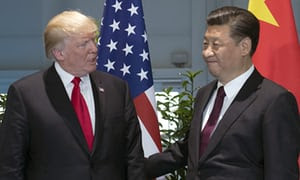As the United States increasingly confronts China over trade and
turns away from decades of championing lower tariffs, Beijing is seen
getting a boost from its globe-spanning — and heavily marketed —
investment program.
turns away from decades of championing lower tariffs, Beijing is seen
getting a boost from its globe-spanning — and heavily marketed —
investment program.
China’s Belt and Road Initiative is a massive infrastructure project
that covers more than 80 countries, claims to seek the revival of
historic Silk Road trade routes. Nomura estimates it could be worth at
least $1.5 trillion in investments over the next 10 years.
that covers more than 80 countries, claims to seek the revival of
historic Silk Road trade routes. Nomura estimates it could be worth at
least $1.5 trillion in investments over the next 10 years.
The aim is to connect China with much of the rest of Asia, Europe,
the Middle East and parts of Africa through massive commerce-boosting
projects such as railroads, highways and ports — increasing China’s
global reach all the while.
the Middle East and parts of Africa through massive commerce-boosting
projects such as railroads, highways and ports — increasing China’s
global reach all the while.
The project has garnered plenty of skepticism from Beijing’s rivals,
but the White House’s push for greater trade benefits could end up
boosting buy-in for the Belt and Road, analysts say.
but the White House’s push for greater trade benefits could end up
boosting buy-in for the Belt and Road, analysts say.
Carlos Casanova, Asia-Pacific economist at French trade credit
insurer Coface, said there could be supply chain disruptions if access
to the world’s largest economy is reduced, so that could force some
countries involved in the Belt and Road to seek increased trade with
China, in turn potentially providing it with more export markets as
well.
insurer Coface, said there could be supply chain disruptions if access
to the world’s largest economy is reduced, so that could force some
countries involved in the Belt and Road to seek increased trade with
China, in turn potentially providing it with more export markets as
well.
China would “be a lot less dependent on the United States” if trade increases with the Belt and Road, he said.
Fred Neumann, co-head of Asian economics research at HSBC in Hong
Kong, also said the Belt and Road Initiative can benefit China amid the
trade standoff with the U.S.
Kong, also said the Belt and Road Initiative can benefit China amid the
trade standoff with the U.S.
”The underlying theme is really connectivity to foster trade
relations,” Neumann said of the initiative. “And to the extent that they
are succeeding in building this, it should help to offset potential
drags on growth or drag on exports to the U.S.”
relations,” Neumann said of the initiative. “And to the extent that they
are succeeding in building this, it should help to offset potential
drags on growth or drag on exports to the U.S.”
‘Plan in the sunshine’
U.S. President Donald Trump’s “America First” program has stoked fears
the country is turning its back on the global trading system it once
nurtured.
the country is turning its back on the global trading system it once
nurtured.
And while critics have called the Belt and Road an overhyped endeavor
aimed at securing China’s 21st Century political and economic dominance
in a geostrategic region, Beijing counters it is for the good of all.
aimed at securing China’s 21st Century political and economic dominance
in a geostrategic region, Beijing counters it is for the good of all.
Speaking in April, President Xi Jinping denied the project was “an
intrigue of China,” the official Xinhua news agency reported. “It is, if
anything, a plan in the sunshine,” Xi reportedly said.
intrigue of China,” the official Xinhua news agency reported. “It is, if
anything, a plan in the sunshine,” Xi reportedly said.
Despite such assurances, it has not been all smooth sailing for the Belt and Road.
Projects have gone sour, such as a debt-laden port in Sri Lanka. And
Malaysia is renegotiating a rail deal after the shock return to power of
Prime Minister Mahathir Mohamad in May, illustrating the political
risks China increasingly faces as its influence grows.
Malaysia is renegotiating a rail deal after the shock return to power of
Prime Minister Mahathir Mohamad in May, illustrating the political
risks China increasingly faces as its influence grows.
And even as China ramps up the project, its outbound foreign direct
investment fell last year for the first time since 2009. In fact,
China’s investments in Asia still pale in comparison to Japan’s.
investment fell last year for the first time since 2009. In fact,
China’s investments in Asia still pale in comparison to Japan’s.
But China has an overwhelming advantage in trade volumes and its commitment to the Belt and Road has not visibly wavered.
Casanova said that despite the overall fall in 2017, investment by China in Belt and Road countries actually increased.
Source: CNBC





